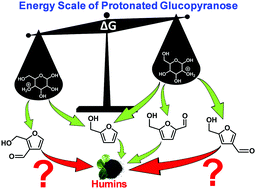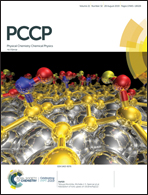Mechanism and theory of d-glucopyranose homogeneous acid catalysis in the aqueous solution phase†
Abstract
A detailed systematic theoretical study of the mechanism of the homogeneous Brønsted-acid catalysis of D-glucose in aqueous solution phase (“acid hydrolysis”) is reported. G4MP2 with the SMD solvation model at B3LYP/6-31G(2df,p) are employed to compute the free energies of the molecular and ionic species pertaining to the isomerization, protonation, hydrogen cation transfer and decomposition processes of D-glucopyranose in aqueous solution phase. This information is used to hypothesise a reaction mechanism that is of improved accuracy and completeness from the existing art. It is found that rotation of the D-glucose alkyl carbon–carbon bond is a facile process and is very important to the subsequent catalytic mechanism. This rotation produces two rotameric isomers which are of notably different thermodynamic stability and reactivity, even with regard to the products of this acid catalysis. As a low energy process (ΔG‡ = ∼3.8–6.7 kcal mol−1), the alkyl carbon–carbon bond may rotate toward the hydroxyl group at the adjacent “4” position reducing the energy required to protonate that position by 3.0–7.2 kcal mol−1 (or 15–30%). The combination of two rotomeric isomers with the six structural isomers owing to the oxygen atoms, means that protonated D-glucose cations embark on a complex competition of interconversion and decomposition that is both thermodynamically and kinetically influenced. The calculations support the hypothesis that the acid-catalysed hydrolysis of D-glucose may yield a number of platform chemicals that have not previously been suggested. These include the prospect of three isomers of 5-hydroxymethylfurfural (HMF); 5-(hydroxymethyl)furan-2-carbaldehyde, 5-(hydroxymethyl)furan-3-carbaldehyde and 5-(hydroxymethyl)furan-4-carbaldehyde. Vibrational spectra of these HMF isomers are also computed and compared to experimentally determined infrared spectra of “humins”. On this basis, it is cautiously speculated that the alternative HMF isomers, may be monomeric constituent of the polymeric “humins”.



 Please wait while we load your content...
Please wait while we load your content...